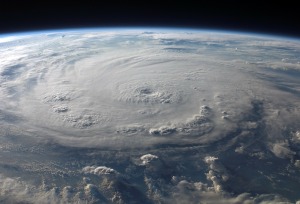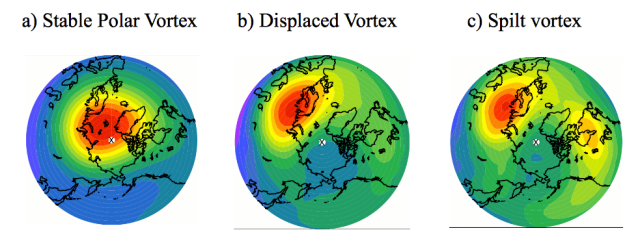 In recent years the stratosphere has become a hot topic in the science community. Many people believe that a better understanding of the stratosphere will lead to a variety of positive implications. These include:
In recent years the stratosphere has become a hot topic in the science community. Many people believe that a better understanding of the stratosphere will lead to a variety of positive implications. These include:
- More sophisticated (and realistic) general circulation models [e.g Mitchell et al., 2013b].
- Lengthened timescales for predictability of the climate and weather systems.
- Better understanding of Northern Hemisphere extreme winter events such as extremely cold temperatures and enhanced snow-fall.
For those of us living in Europe can you remember the weather in January 2013? Does anything in particular spring to mind…? If it doesn’t I shall remind you, it was very very cold!! Interestingly this could be blamed on the stratosphere. On January the 10th there was a major Sudden Stratospheric Warming and as we shall see later (Section: Why Do We Care?), this probably contributed to the extreme weather. For a very nice discussion on the cold January 2013 weather and it’s possible causes see this Met Office article by Prof. Julia Slingo.
To know why we should care about the stratosphere we must understand what it is to begin with.
The Stratosphere
So what exactly is the stratosphere and how does it behave? Well it is the section of atmosphere that lies approximately in the 10 to 50 km range and contains the ozone maximum. Technically its lower boundary (the tropopause) is defined to be where the environmental lapse rate abruptly changes and the atmosphere starts to warm with height. This induces a statically stable environment (warmer air above colder air) with potential temperature increasing with height.
Due to the troposphere being extremely cold water vapour struggles to be transported into it through the tropopause. Although, that being said, some can be transported in the tropical areas. The other source of water vapour is local production due to the oxidisation of methane. This process means that water vapour increases with height in the stratosphere. Water vapour is a potent green-house gas and very important.
As mentioned previously the stratosphere is home to the ozone maximum which resides at approximately 22km and is essential for life on Earth. If the entire column was brought to a standard temperature and pressure (0°C and 1,000 hPa) and globally averaged then it would only be 3mm thick [Andrews et al., 1987] . Ozone is created by photolysis of O2 by UV radiation. A crucial component of the ozone cycle is its catalytic destruction by specific chemical species (e.g. H, OH, NO, Cl and Br ). Increases in these species and the formation of stratospheric polar clouds provide a shockingly efficient mechanism for the destruction of ozone and has contributed to the formation of the Antarctic ozone hole. Ozone variations will affect the amount of energy absorbed by the stratosphere (and hence the temperature) consequently it also affects the amount of radiation reaching the earth’s surface.
A sudden stratospheric warming can vividly portray the coupling between the stratosphere and the troposphere [Mitchell et al., 2013a]. This phenomenon is discussed in the next section.
What is A Sudden Stratospheric Warming?
To understand what a sudden stratospheric warming is we must begin by understanding how the stratosphere usually behaves in the Northern Hemisphere’s winter…. but why winter? Well these events only occur when planetary waves can propagate vertically up through the troposphere. It is widely accepted that these waves initiate sudden stratospheric warmings. In the summer the planetary waves can’t escape the troposphere and so there are no sudden stratospheric warmings after March. Also, it is prudent to note that sudden stratospheric warmings do not usually occur in the Southern Hemisphere (except for one extraordinary event in 2002!), so discussion will be restricted to Northern regions.
So now we know that winter is the key period of interest we can look into its usual state, the climatology, and figure out why a sudden stratospheric warming is so different. The usual temperature profile during this period is a warmer equator with the temperature reducing as you travel towards the pole. In the autumnal months a cold polar vortex forms that has strong cyclonic flow, this means that there are westerly winds in the stratosphere during winter. This polar vortex remains throughout the season until March or April when it will break down in what’s known as a final warming.
Armed with this knowledge a sudden stratospheric warming can be defined! Formally it is:
- A reversal of the zonal mean zonal wind at 10hPa (approximately 30km) – so the winds change from the usual westerly state and become easterly.
- A warming towards to the pole.
The World Meteorological Organization (WMO) provides this definition, which is traditionally used in the literature. However; there are other methods of identifying these warmings events, e.g. Mitchell et al. [2011], and Limpasuvan et al. [2004].
There are two types of warming, the first one causes the vortex to shift from its polar location and travel equatorward which is called a displacement event. The second type involves a splitting of the vortex into two smaller daughter vortices, this is called a spitting event.
The different behaviours of the polar vortex are portrayed in the three images above. The stable polar vortex is shown in (a). This is the usual state that the vortex is in with the red colour depicting the centre of the vortex and the coldest area. In (b) a typical displaced state of the polar vortex is presented, this is created by averaging over 33 displacement events. The centre, red area, has moved off the pole and is now positioned over Eurasia. Finally, in (c), an average over 22 split vortex events is shown. Two daughter vortices are clearly evident with one placed over Canada and one over Eurasia.
Why Do We Care?
Well we care because it is interesting! But if that isn’t a satisfying answer, and you are not a complete science geek, then we care due to the positive impacts of understanding the stratosphere and its sudden warmings. There is mounting evidence that during these events the stratosphere is strongly coupled to the troposphere and there are particular surface effects which are associated with either split or displacement events. This is clearly highlighted by Mitchell et al. [2013a]. It is discovered that split events have an enhanced ability for their anomalies to descend through the atmosphere and lead to a strong negative Northern Annular Mode. This anomaly can remain for the following 60 days (yes you read that right; 2 months!!). A negative Northern Annular Mode at the surface leads to a weaker storm track over the North Atlantic. This promotes colder and drier weather over Europe.
In January 2013 a split event (see here for a cool video of this) occurred, which probably led to the freezing January a lot of us experienced. Again I invite you to read Prof. Julia Slingo’s article for a summary of all the possible causes.
So we care because the stratosphere is very interesting and unappreciated (maybe less so in recent year), and it may also allow us to predict extreme winter weather up to 2 months in advance!! Now I don’t know why anyone wouldn’t think that is great.
References
D Andrews, J Holton, and C Leovy. Middle Atmosphere Dynamics. Academic Press, 1987.
M Baldwin and T Dunkerton. Stratospheric harbingers of anomalous weather regimes. Science, 294:581–584, 2001.
L Gerber, A Butler, and N Calvo. Assessing and understanding the impact of stratospheric dynamics and variability on the earth system. Amer. Meteor. Soc., 93:845–859, 2012.
V Limpasuvan, D Thompson, and D Hartman. The life cycle of the northern hemisphere sudden stratospheric warmings. J. Climate, 17:2584–2596, 2004.
D Mitchell, A Charlton-Perez, and L Gray. Characterizing the variability and extremes of the stratospheric polar vortices using 2d moment analysis. J. Atmos. Sci., 68:1194–1213, 2011.
D Mitchell, L Gray, J Anstey, M Baldwin, and A Charlton-Perez. The influence of stratospheric vortex displacements and splits on surface climate. Geophys. Res. Lett., 26:2668–2682, 2013a.
D Mitchell, P Stott, L Gray, M Allen, F Lott, N Butchart, S Hardiman, and S Osprey. The impact of stratospheric resolution on the detectability of climate change signals in the free atmosphere. Geophys. Res. Lett., 40:937–942, 2013b.










